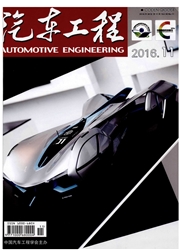

 中文摘要:
中文摘要:
鉴于新法规GB 14167—2013《汽车安全带固定点》要求全车座椅都配备三点式安全带,导致座椅质量和荷载增加,本文中对某M1类车辆的座椅结构改进和轻量化。首先,对原车单体座椅安全带固定点试验进行建模仿真的结果表明,中间座椅安全带上固定点的最大前向位移为433.1mm,超过RC平面,不满足法规要求。据此,基于传力路径提出结构改进方案,该方案仅使座椅质量增加0.18kg,却使中间座椅安全带上固定点最大前向位移减小至104.3mm,最大应变由0.56减小至0.163,满足法规要求。接着,将满足法规要求的单体座椅放入白车身中进行分析,结果中间座椅安全带上固定点最大前向位移和最大应变分别增至220.9mm和0.198,但仍满足法规要求。进一步通过灵敏度和应变分析对中排座椅提出轻量化方案,仿真结果是座椅质量减轻了1.95kg,而中间座椅安全带上固定点的最大前向位移仅增加了10.4mm。最后进行验证试验。结果表明:仿真与试验结果很好吻合,安全带上固定点的前向位移仅相差8.7mm,前后支撑脚、安全带两个下锚点和车身地板的变形模式与幅值均与试验接近。
 英文摘要:
英文摘要:
In view of that state regulation GB 14167—2013 "Safety-belt anchorages,…" requests all seats in vehicle being equipped with three-point safety belt, leading to the increases in mass and loads born by seat, the seat structure modification and lightweighting are conducted on a M1 vehicle in this paper. Firstly the modeling and simulation are performed on the regulation test on the safety belt anchorage points of single seat and the results show that the maximum forward displacement at the upper anchorage point of middle seat safety-belt reaches 433mm, go-ing through RC plane, failing to meet regulation requirements. Thus a structure modification scheme based on force transmission is implemented resulting in an increase of seat mass of only 0. 18kg, but the maximum forward dis-placement at anchorage point reducing to 104. 3mm and the maximum strain decreasing to 0. 163 from 0. 56, meet-ing regulation requirements. Then the single seat meeting regulation requirements is incorporated into body-in-white and a corresponding simulation results in the maximum forward displacement at anchorage point and strain increasing to 220. 9mm and 0. 198 respectively, still meeting regulation requirements. Furthermore, a lightweighting scheme is proposed by using sensitivity and strain analyses and proceeded with a result showing that the seat mass reduces by 1. 95kg while the maximum forward displacement at anchorage point rises by only 10. 4mm. Finally a validation test is carried out and the results indicate that the simulation results are well agree with test ones, specifically their difference in the maximum forward displacement at anchorage point is only 8. 7mm and the deformation mode and magnitude of the front and rear supporting legs, two lower anchorage points of safety belt and rear floor are close to that of test.
 同期刊论文项目
同期刊论文项目
 同项目期刊论文
同项目期刊论文
 期刊信息
期刊信息
